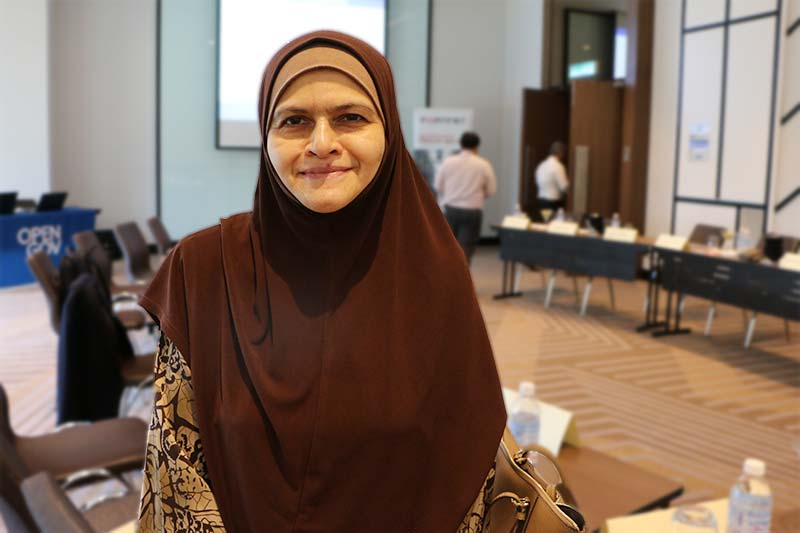
OpenGov speaks to Puan Azizah Hamzah, Director of K-Economy (Knowledge Economy) Section, Economic Planning Unit, Prime Minister’s Department (EPU, PMD) about driving ICT in the Eleventh Malaysia Plan, 2016-2020.
Puan Azizah said, “The Plan emphasises driving ICT in the knowledge economy though innovation and productivity, to enhance competitiveness and wealth creation.”
Several ICT initiatives continued to be implemented to transform Malaysia from a resource-dependent economy to a knowledge-based digital economy, during the Tenth Malaysia Plan (Tenth Plan), 2011-2015.
Malaysia was last ranked 48 out of 146 countries in the Knowledge Economy Index (KEI) developed by the World Bank. The KEI, based on the four pillars of education and training, information infrastructure, economic incentive and institutional regime, and innovation system, represents a country’s ability to generate, adopt and diffuse knowledge.
Though Malaysia is situated at a relatively strong position with respect to innovative capacity, it is not yet translating efficiently into wealth generation, reflecting a gap in domestic commercialisation of innovations. There is scope for improvement in commercialisation of patents owned by Government Research Institutes (GRIs) and Institutions of Higher Education (IHEs).
The K-economy section, EPU looks at the ICT infrastructure, ICT industry and ICT related human capital. The unit also tracks indicators to determine the strategy and direction for future planning.
ICT is looked upon as a sector itself, and also as an enabler of other sectors and industries. In the former instance, the focus is on increasing the contribution of ICT to the GDP. In 2015, the ICT sector as a whole accounted for 16.8% of Malaysia’s GDP, compared to 15.8% in 2010. The sector grew by 6.8% per annum from 2010-2015. ICT services as well as media and content accounted for 33% of total ICT output, while ICT manufacturing and e-commerce constituted 28.4% and 23.2% respectively.
ICT services is increasing progressively but the increase for now is not enough to offset the decline in manufacturing. Puan Azizah explained that the contribution of ICT manufacturing has been moving down gradually, as part of a planned transition to high-value services. This is in line with the National Strategies to drive growth based on high value-added services and manufacturing.
ICT as an enabler of other sectors aims to enhance technology absorption in Small and Medium Enterprises (SMEs) in sectors ranging from agriculture and manufacturing to legal and healthcare and to support the adoption of e-commerce by online platforms for Micro-Enterprises (MEs).
1. Enhancing competitiveness of the ICT industry
Malaysia’s vision of being an advanced economy and inclusive nation will be built among others, upon a knowledgeable society supported by a robust, vibrant and a sustainable ICT industry. Efforts will be strengthened to drive ICT through four main strategies, namely re-energising the ICT industry, ensuring supply of high quality ICT human capital, improving digital infrastructure and pursuing digital inclusion.
In order to achieve an 18.2% or approximately RM324.9 billion ICT contribution to GDP by the year 2020, planned initiatives include the development of technology focus areas, infusion of ICT in other sectors and building the support ecosystem.
Puan Azizah elaborated, “From discussions with the industry and from prior studies, we identified a number of focus areas which include digital content, software development and testing, Internet of Things, data centres and cloud services, cybersecurity and Big Data Analytics. The aim is to move from consumption to production, to build the local industry, to enable jobs creation and export opportunities.”
For instance, with regards to cloud services, the strategy includes attracting global cloud service providers while building clusters of domestic companies to complement their services. Software developers would be encouraged to offer their services on the cloud, while SMEs will be encouraged to move to the cloud to lower their barriers to entry.
Another example is software development and testing. The Malaysia Software Testing Hub (MSTH) programme was initiated in 2009. Internationally certified software testing facilities have been built. Training programmes have been developed for graduates from IT, engineering and sciences, as well as companies that wish to train and certify their in-house software testers.
Special focus will be given to nurture and groom start-ups through various programmes of capability development and promoting internationalisation.
2. Talent development in ICT
Puan Azizah laid stress on the importance of developing high quality ICT human capital to support the ICT industry. In line with this aspiration, the ICT curriculum will be strengthen and computational thinking will be integrated into the learning modules in schools.
Closer collaboration between the industry and academia is planned to create ICT courses, recognised by professional bodies and which meet the industry’s requirements and bridge the demand-supply gap. SMEs are also being encouraged to inculcate a culture of training and upgrading skills.
3. Improving coverage, affordability and quality of digital infrastructure
Puan Azizah stressed on accessibility as a key and indispensable aspect of the ICT strategy. The capacity and coverage will be further improved to support social economic growth with focus of efficiency and affordability of services.
A 2011 amendment to the Uniform Building By-Laws, making broadband an essential service has been gazetted by a number of states where it is planned that these states will be fibre ready by 2018. Developers will be required to provide ready-to-use communication infrastructure for new housing and commercial developments.
The High Speed Broadband 2 (HSBB2) initiative aims to provide connectivity of 100Mbps to all households in state capitals and selected high-impact growth areas. Simultaneously, plans for the Sub-Urban Broadband (SUBB) entail access to 20Mbps broadband for 50% of households in sub-urban and rural areas by 2020.
A periodically reviewed Access Pricing Framework is expected to reduce fixed broadband cost from 2.42% of GNI (Gross National Income) per capita in 2013 to 1% in 2020. At the same time, the Communications and Multimedia Act 1998 will be strengthened to provide consumers clear and specific criteria to measure the Quality of Service of service providers, and protect their rights in cases where minimal acceptable standards are not met.
Connectivity, as understood in terms of a network of pervasive broadband, sensor networks and applications, is also an essential component for enabling areas of focus identified by the Smart Cities strategy.
4. Digital inclusion
Strategies proposed under digital inclusion consists of support through digital platform for micro-enterprises, micro sourcing for the bottom 40% housholds income group (B40) as well as collaboration with IHEs, the private sector and NGOs. The eRezeki programme by Malaysia Digital Economy Corporation (MDEC) is an example of a project targeted for the B40. It is an e-entrepreneurship program which profiles the target groups and matched them to the jobs available.
“The eRezeki initiative is based on the concept of crowdsourcing. The initiative aims to assist the low-income household by enabling and connecting them to the digital income opportunities. Through eRezeki, interested participants will be trained, qualified and matched against suitable available tasks. By participating in eRezeki, participants can earn additional income and develop skills.”
The approach is to identify and replicate successful programmes to benefit the wider B40 households. Rather than outright replication, programmes are customised to meet local requirements.
Programmes for MEs to help convert their businesses from traditional to digital and to incorporate e-commerce. The MEs will be provided secure online platforms to build their confidence in performing online transactions and adopting e-payment methods.
“The divide is not just rural, the divide is also between the abled and the disabled. We also have ICT based programmes for the disabled for example PDKnet which is implemented by the social welfare department”, Puan Azizah said.
‘Government does not work in isolation’
While some agencies drive policy, allocate budgets and monitor progress, execution is carried out by ministries and other agencies. Collaboration with academia, private sector and NGOs is also crucial.
Puan Azizah told OpenGov, “Initiatives are driven together with ministries and agencies because no one agency works alone. Through this collaboration we aspire to achieve the targeted goals of the Eleventh Malaysia plan in transforming the ICT industry, from ‘supply- to demand-driven, consumption to production and low knowledge-to high knowledge-add.”
















